



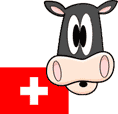
Now here's something a little different, for Switzerland at least. It's a conventional adhesion electric metre gauge railway, no rack or pinions, isolated from any other railway but connected by an aerial cable car at one end. Your journey would typically start upon arrival at the Berner Oberland Bahn's (BOB) Lauterbrunnen depot. A short walk, directly across the street, lies the cable car terminus where passengers board for a ride that climbs 2,264 feet (690 metres) for a distance of 0.9 miles (1.4 kilometres) straight up the mountain to the Bergbahn Lauterbrunnen Mürren (BLM) railway station at Grütschalp. This aerial cableway is relatively new having begun operation in 2006.
 Prior to 2006 a funicular connected Lauterbrunnen and Grütschalp. What remains of the funicular may still be viewed when travelling on the cable car. Rumour had it the old funicular was used to transfer BLM rolling stock to and from the rail line but this seemed unlikely until this blurry photo was discovered. In 2013 triebwagen (railcar) number 31 was trucked over the hazardous mountain roads to replace old number 11 and augment service on the line. The difficulty in replacing rolling stock perhaps explains why the current BLM railcars, class BDe 4/4 built in 1967, haven't been upgraded and are still in operation.
Prior to 2006 a funicular connected Lauterbrunnen and Grütschalp. What remains of the funicular may still be viewed when travelling on the cable car. Rumour had it the old funicular was used to transfer BLM rolling stock to and from the rail line but this seemed unlikely until this blurry photo was discovered. In 2013 triebwagen (railcar) number 31 was trucked over the hazardous mountain roads to replace old number 11 and augment service on the line. The difficulty in replacing rolling stock perhaps explains why the current BLM railcars, class BDe 4/4 built in 1967, haven't been upgraded and are still in operation.
 The original funicular that began operation in 1891 was water and gravity powered. In 1902 it was converted to electric power. This drawing dated 1905 shows the details of a funicular car built by Schweizerischen Locomotivfabrik at Winterthur. The old funicular connection between Lauterbrunnen and Grütschalp started at the lower terminus on the Hauptstrasse (main street). A newer building replaced the original 1891 structure at some point but the terminus still remains at the same location. The funicular joined these two locations until it was abandoned in favour of an aerial cableway in 2006. The abandonment was mainly due to land slips which at one point had deformed the funicular's trackage. The aerial cableway was chosen as the most cost effective solution over the protests of local citizenry who wanted to retain the funicular. In addition to carrying passengers the funicular also provided for freight transport with an open top container. This metal box rode behind, or below, the funicular as it climbed the 2,264 feet up the side of the mountain to Grütschalp. Once there the container and its load was transferred to a flatcar pulled by one of the triebwagen (railcars) for delivery to Winteregg or Mürren at the end of the line. Or vice versa, what goes up, must come down.
The original funicular that began operation in 1891 was water and gravity powered. In 1902 it was converted to electric power. This drawing dated 1905 shows the details of a funicular car built by Schweizerischen Locomotivfabrik at Winterthur. The old funicular connection between Lauterbrunnen and Grütschalp started at the lower terminus on the Hauptstrasse (main street). A newer building replaced the original 1891 structure at some point but the terminus still remains at the same location. The funicular joined these two locations until it was abandoned in favour of an aerial cableway in 2006. The abandonment was mainly due to land slips which at one point had deformed the funicular's trackage. The aerial cableway was chosen as the most cost effective solution over the protests of local citizenry who wanted to retain the funicular. In addition to carrying passengers the funicular also provided for freight transport with an open top container. This metal box rode behind, or below, the funicular as it climbed the 2,264 feet up the side of the mountain to Grütschalp. Once there the container and its load was transferred to a flatcar pulled by one of the triebwagen (railcars) for delivery to Winteregg or Mürren at the end of the line. Or vice versa, what goes up, must come down.During 2006 most of the funicular was demolished during construction of the replacement aerial cableway. Today, as the cable car travels up and down the mountainside, the container hangs beneath the cable car. At Grütschalp, the container is transferred to a railway flatcar for delivery along the line by a sophisticated, specially designed, double forklift machine. This interesting five minute video shows two containers being interchanged between flatcar and cable car. Passengers at Grütschalp load or unload while a container transfer is in progress. The whole system is very inventive.
This metre gauge (3 feet 3 3/8 inches) adhesion railway (no rack and pinions) is just 2.6 miles (4.27 kilometres) in length and connects Grütschalp to Mürren with an intermediate stop named Winteregg where there are two platforms, passing track, and a restaurant. Due to the poor road access the line and connecting cable car at Grütschalp provides a vital link for passengers and freight from Lauterbrunnen, at the base of the valley, to end of track at Mürren, high on a shelf overlooking the Lauterbrunnen Valley. Mürren's modern station opened in 1965 and there is a freight depot located next to the station. Travelling along the line there are views of the Eiger, Mönch, Black Mönch, and Jungfrau mountains on the opposite side of the valley. The railway is owned by Jungfraubahn Holding AG, a holding company which also owns the Wengernalpbahn and Jungfraubahn. The railway opened in 1891 then was converted to 560 Volt Direct Current operation in 1912. The maximum grade is 5 percent.| Number | Class | Built | Gauge | Power | V max |
| BLM 1 | Ge 2/2 | 1891 | 1 metre | 560 VDC | ? kph |
| BLM 11 | CFe 2/4 | 1913 | 1 metre | 560 VDC | 25 kph |
| BLM 21 | BDe 4/4 | 1967 | 1 metre | 560 VDC | 30 kph |
| BLM 22 | BDe 4/4 | 1967 | 1 metre | 560 VDC | 30 kph |
| BLM 23 | BDe 4/4 | 1967 | 1 metre | 560 VDC | 30 kph |
| BLM 31 | Be 4/4 | 1966 | 1 metre | 560 VDC | 30 kph |
The Swiss classification system was created by the Swiss federal railways department, and applied originally to the rolling stock of private railways, operating under government concessions. In 1902, when the Swiss Federal Railways was founded as a government railway, that new railway also became bound by the system. Unlike the Whyte notation system which is used to classify wheel arrangements, the Swiss system, in both its original and updated forms, takes into account a number of different variables. The Swiss system is also less precise than other systems in the way it deals with axles, because it refers only to numbers, rather than to arrangements of powered axles, and axles as a whole. Therefore the Swiss system is more a method of classifying locomotive and railcar types and series than a method of classifying wheel or axle arrangements.
| Facilities | Meaning |
| A | Vehicle with first class compartment. |
| B | Vehicle with second class compartment. |
| C | Vehicle with third class compartment. |
| D or F | Vehicle with luggage compartment. |
| G | Narrow gauge locomotive for adhesion operation. |
| K | Covered freight railcar. |
| O | Open freight railcar. |
| R (leading) | Multiple unit with Vmax of at least 110 kph. |
| R (trailing) | Restaurant or Buffet. |
| S | Vehicle with special compartment. |
| ST | Self-propelled special flat wagon. |
| X or V | Service vehicle. |
| XT or VT | Self-propelled service vehicle. |
| Z | Vehicle with post office compartment. |
| Type | Meaning |
| blank | Steam powered. |
| a | Battery powered. |
| e | Electric powered. |
| m | Fuel powered (diesel or gasoline). |
| h | Rack and pinion drive vehicles. |
| Facilities | Type | Driven Axles | slash | Total Axles | Series |
| CF | e | 2 | / | 4 |
CFe 2/4 - This is an adhesion only railcar with third class seating and a luggage compartment powered by electricity with only 2 driving axles out of 4.
| Facilities | Type | Driven Axles | slash | Total Axles | Series |
| BD | e | 4 | / | 4 |
BDe 4/4 - This is an adhesion only railcar with second class seating and a luggage compartment powered by electricity with 4 driving axles out of 4.
| Facilities | Type | Driven Axles | slash | Total Axles | Series |
| B | he | 4 | / | 8 |

Bhe 4/8 - This railcar has second class seating and is rack only railcar powered by electricity with 4 driving axles out of a total of 8. It's known as a "Panorama" railcar built by Stadler for the Wengernalpbahn.
| Facilities | Type | Driven Axles | slash | Total Axles | Series |
| Ab | eh | 8 | / | 12 |
Abeh 8/12 - This railcar has first and second class seating. In this case, for some strange reason, a lowercase "b" is used to indicate second class compartments. It is powered by electricity and is a rack and adhesion railcar with 8 driving axles out of a total of 12. It's the first manufactured version of this type of railcar known as the "Allegra" built by Stadler for the Rhätische Bahn.
2005 - Canton Parliament Wants to Replace Funicular
22 Mar 2006 - New Bergbahn Lauterbrunnen Mürren Aerial Cableway Construction
19 Jul 2006 - Cable Car Valley Station is Erected
16 Dec 2006 - New Lauterbrunnen Grütschalp Aerial Cableway in Operation
30 Oct 2008 - Jungfraubahnen Operation Back to Normal
11 May 2011 - 50 Percent More Electricity from as Early as June
20 Jun 2012 - Open Air Cinema at Winteregg
3 Sep 2013 - Aerial Cableway Back in Operation
9 Jul 2015 - Four Climbers Die in Lauterbrunnen Accidents
28 Jan 2016 - New Manager of Lauterbrunnen Car Park
1 Feb 2016 - Jungfraubahn Holding AG Takeover Bid
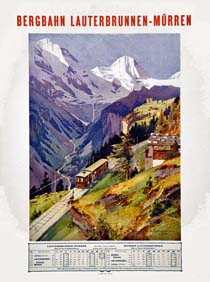
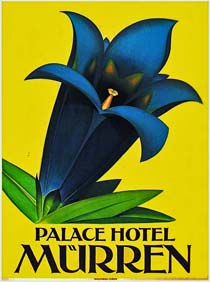
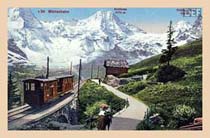
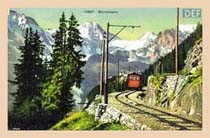
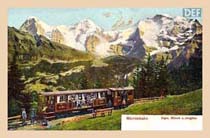
Bergbahn Lauterbrunnen Mürren (part of Jungfraubahnen)
Drawing of 1890's BLM locomotive and personenwagen
Switzerland by Rail
Railfan Europe Picture Gallery
Funimag
YouTube Video BLM Triebwagens
YouTube Video Grütschalp Forklift
Lauterbrunnen Car Park
Paper Model BLM No. 1-3
Swiss Heritage Railways
Hotel Bellevue Mürren
Swiss Info
Prellbock Druck & Verlag
 On 14 Aug 1891 the mountain railway from Lauterbrunnen to Mürren began operation. It consisted of two sections, the funicular from Lauterbrunnen to Grütschalp with a length of 1,217 metres and a maximum gradient of 61 percent which was a water-powered ballast funicular at that time. The second section was a metre gauge electric powered adhesion railway from Grütschalp to Mürren with a length of 4,323 metres and a maximum gradient of 5 percent. The funicular underwent various modifications being converted to electric operation in 1902 then modernized between 1948 and 1951. Due to geological difficulties the funicular eventually had to be replaced by a cable car in 2006. Since 1967 third generation BLM rolling stock has been in use. The BLM still owns an historic motor coach from 1913. Text is German.
On 14 Aug 1891 the mountain railway from Lauterbrunnen to Mürren began operation. It consisted of two sections, the funicular from Lauterbrunnen to Grütschalp with a length of 1,217 metres and a maximum gradient of 61 percent which was a water-powered ballast funicular at that time. The second section was a metre gauge electric powered adhesion railway from Grütschalp to Mürren with a length of 4,323 metres and a maximum gradient of 5 percent. The funicular underwent various modifications being converted to electric operation in 1902 then modernized between 1948 and 1951. Due to geological difficulties the funicular eventually had to be replaced by a cable car in 2006. Since 1967 third generation BLM rolling stock has been in use. The BLM still owns an historic motor coach from 1913. Text is German.
